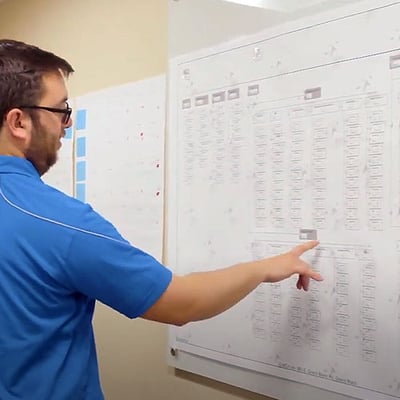The construction industry is filled with ever-changing conditions that threaten the timeline and budgets of projects every day. From weather to supply chain and everything in between, project leaders know the best-laid plans are bound to change.
So, what’s a project leader to do? How can they predict a timeline that allows for unpredictable delays and interruptions such as materials delivery and availability issues, staff illness, or subcontractor schedule clashes? Enter Agile Construction® Project Management.
Finding a Solution with Agile Construction
Lemberg uses Agile Construction Project Management (Agile CPM) techniques to manage the day-to-day details of large projects, giving us the ability to quickly adjust to any unplanned snags and avoid larger issues. We recently interviewed two Lemberg team members about Agile CPM and how it has helped streamline timelines and improve project delivery.
Adam Grahn, project manager, and Mackenzie (Mack) Miller, project foreman, are strong proponents of Agile CPM and have been leading the way in its implementation here at Lemberg. They’ve used Agile CPM throughout projects that span the healthcare, education and commercial sectors.
Here’s what they had to say about the positive effects of Agile CPM techniques on a project’s team, timeline and budget:
What Is Agile Construction Project Management?
Adam: Agile CPM is a method in which a project is broken down into smaller tasks or goals that are used to measure and manage a project in real time. We can see all the small tasks that add up to create the project as a whole. We can see tasks that typically get overlooked, such as time spent in meetings, inspections, receiving deliveries, and managing material, and how these affect the overall schedule. This work breakdown is immensely beneficial in tracking obstacles and providing feedback to all project stakeholders. Together, they help create a seamless transition between trades and a timely project.
What Is The Greatest Benefit of Agile CPM?
Adam: Overall, the value of using Agile CPM is we can provide specific progress updates. It helps us to be proactive. We can visually track the project's progress and identify project setbacks using data, charts, and graphs that other trades simply don't have. Breaking the project into smaller tasks allows us to review progress consistently and better manage risk. We remain flexible and able to respond quickly to the project's changing demands.
Does the Agile CPM Process Take More Time?
Mack: Agile Construction does take a bit of time upfront, especially to map out the whole breakdown process. Depending on the size of the job, the Agile process could be 3-5% of the total hours for the job. However, the time spent detailing the job early on helps identify potential issues and obstacles before they escalate into significant problems, saving you time in the long run. By anticipating and addressing challenges early on through Agile CPM, the project team can avoid costly delays and rework, ultimately accelerating the project timeline. This aligns with the core principle of the Agile CPM approach, which prioritizes adaptability, efficiency, and continuous improvement throughout the construction project lifecycle.
With Agile CPM, projects are broken down into manageable tasks, enabling real-time tracking and seamless adaptation to evolving challenges. While Agile CPM requires more time upfront, it saves extensive time in the long run.
How Does Using Agile CPM Techniques Improve Safety?
Mack: Utilizing Agile CMP allows you to know what you will be doing in the next few days or weeks, which helps you coordinate equipment, tools, and personal protection equipment so that it’s on the job before it’s actually needed. Also, it allows you to be proactive and gets you thinking about more ways to get the job done as safely as possible.
Adam: With Agile CMP, we’re able to plan ahead and avoid congestion on the job site. Coupled with offsite prefabrication, we can schedule crews safely for maximum productivity.
How Have Agile CPM Techniques Benefitted Your Role, Your Team and Your Project?
Mack: Agile CPM has given me a better way to plan a project and catch things upfront that we might otherwise miss. It helps to plan the project all the way to the end – before the job starts. Whether we’re planning a few days out or a week or two, any obstacles or trade clashes can be avoided through Agile Construction. Better planning and timing of the crew’s daily tasks will always lead to more productivity.
Adam: In what can be a very transactional role as a subcontractor, Agile CPM has made projects much more relationship-based. It is a very transparent way of showing our work. We partner closely with other trades to provide timely progress updates, identify challenges and more accurately predict the completion schedule for each stage of a project. Agile CPM allows for the close involvement of all parties involved, which is key to a successful construction project.
Why Choose Agile CPM?
Agile Construction Project Management is a proven solution in navigating the complexities of any construction project. By embracing Agile CPM techniques, project leaders can effectively anticipate and mitigate challenges, streamline communication between trades, and ensure smoother project execution.
At Lemberg, our commitment to Agile CPM is what sets us apart from other electrical construction contractors in the industry. Through Agile CPM, we are able to predict and manage the intricacies of large-scale projects with agility and precision. Our customers get the most accurate project picture from bid to bill.
Learn more about how Lemberg is using Agile Construction to improve our project delivery processes. Visit our Agile Construction service page.